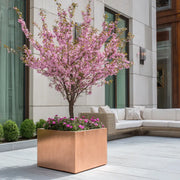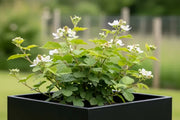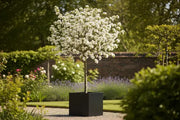Redbud Trees: Your Guide to Spring's Spectacular Showstoppers
Often referred to as Redbuds, Cercis trees are increasingly popular in British gardens, offering a truly magnificent spectacle as spring unfolds. These deciduous trees and large shrubs are cherished for their dramatic early floral display, appearing before the leaves emerge, making them a superb choice for adding vibrant colour to the English landscape.
The flowering period typically begins in early to mid-spring, usually around April to May, depending on the specific species and local weather conditions. Clusters of small, pea-like flowers, often in shades of vivid pink, purple, or sometimes white, erupt directly from the bare stems and even the main trunk – a botanical phenomenon known as cauliflory. This unique characteristic creates a breathtaking display, transforming the tree into a cloud of blossoms. Following this impressive floral show, heart-shaped leaves unfurl, often starting with a reddish or bronze tint before maturing to a lush green. Some cultivars, such as Cercis canadensis 'Forest Pansy', retain a striking purple foliage throughout the growing season, offering extended interest.
After the flowers fade, they are succeeded by distinctive, flattened, pea-like seed pods. These pods, initially green, mature to a reddish-brown or purple colour and can persist on the tree well into autumn and even winter, providing an additional decorative feature. While not typically eaten, they contribute to the tree's ornamental value.
Growing Cercis in the English climate is generally straightforward, as they are remarkably adaptable. They thrive best in a position of full sun to partial shade, ideally sheltered from harsh, cold winds which can damage early blooms. A location that receives at least six hours of direct sunlight daily will encourage the most prolific flowering. They prefer a well-drained, fertile soil, ideally with a neutral to alkaline pH, though they will tolerate slightly acidic conditions. Avoid waterlogged or heavy clay soils, as this can lead to root rot. When planting, dig a hole twice as wide as the root ball and just as deep. Ensure the top of the root ball is level with the soil surface. Water thoroughly after planting and keep the soil consistently moist during the first year to help establish a strong root system. Once established, Cercis are reasonably drought-tolerant, though supplemental watering during prolonged dry spells will be beneficial.
Pruning requirements are minimal. Generally, only prune to remove dead, damaged, or crossing branches, or to maintain a desired shape. The best time to prune is immediately after flowering, as pruning too late in the season can remove next year's flower buds. Cercis are hardy throughout much of the UK, typically tolerating temperatures down to -15°C to -20°C (H5-H6 hardiness ratings). In colder, exposed regions, a sheltered spot is advisable.
For those with limited space or wishing to add a striking feature to a patio or balcony, many varieties of Cercis are suitable for cultivation in large planters. Dwarf cultivars or those with a weeping habit, such as Cercis canadensis 'Ruby Falls' or 'Lavender Twist', are particularly well-suited. When planting in a container, choose a pot with good drainage holes that is at least 50-60cm in diameter for a young tree, and be prepared to pot it up into a larger container as it grows. Use a high-quality, free-draining potting compost mixed with some grit or perlite to improve drainage. Container-grown trees will require more frequent watering than those in the ground, especially during dry periods, as their roots are more exposed to drying out. Regular feeding with a balanced liquid fertiliser during the growing season will also be necessary. In winter, move potted Cercis to a more sheltered spot or wrap the pot in bubble wrap or hessian to protect the roots from freezing temperatures, especially in colder parts of the UK.
Whether planted as a magnificent specimen tree in a lawn, integrated into a mixed border, or as a feature in a planter, Cercis trees are invaluable assets for any British garden, promising an unforgettable display of spring colour.





















